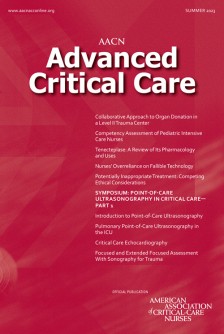Newswise — Improved organ donation practices and greater program visibility led to a sustained increase in referrals, donors and transplanted organs at a Georgia hospital, thanks to a focus on enhanced staff education and family communication.
“Collaborative Approach to Organ Donation in a Level II Trauma Center” details the steps taken at Northeast Georgia Medical Center’s hospital campus in Gainesville, as part of a multidisciplinary initiative to increase its organ donation rate. The article is published in AACN Advanced Critical Care.
Co-author Jesse Gibson, MBA, BSN, RN, TCRN, is the trauma program director and chair of the Donation Advisory Committee at the trauma center, which serves 18 counties in a predominantly rural area. Part of a five-hospital health system, the medical center serves more than 2,600 trauma patients annually, with 95% having blunt trauma. Since the initiative was conducted, the hospital has been nationally verified as a Level I trauma center by the American College of Surgeons Committee on Trauma.
“By investing in staff members and partnering with bedside providers, our facility improved the organ donation experience for nurses, physicians, donors, and families,” Gibson said. “The outcome of that investment has been a hospital culture that values and celebrates organ donation as a standard of care for patients and families and an important part of honoring end-of-life wishes.”
The performance improvement initiative began at the end of 2017 as a way to address concerns about lower than expected metrics related to the medical center’s organ donation process. Initial reviews of patient care revealed deviations from best practice, including missed referrals, members of the care team initiating discussions about donation with families and misconceptions about the donation process.
The Donation Advisory Committee helped clarify language and revise policies related to end-of-life care, partnering with the hospital liaison at its organ procurement organization to increase physician and staff education and provide visibility for the process. Beyond engaging staff to reinforce the expected practice, a transitional language guide was provided to physicians and advanced providers to assist them in any initial discussions that may arise with families. A series of organ donation presentations in 2018 and 2019 provided staff education and encouraged dialogue about the process, as well as review of the most recent organ and tissue data, metrics and expectations.
To improve the program’s visibility, the project team arranged for a “Donate Life” flag to be raised on the main campus each time a family authorized organ donation. The team also implemented an “honor walk” to recognize the donor and family as donors are transported from the inpatient area to the operating room for organ procurement, with staff members lining the hallway to show respect and support. In 2019, the hospital held its first donation remembrance celebration, attended by families of organ donors and the clinical staff members who cared for them.
Since the project began, the number of organ referrals, donors and transplanted organs has increased each year, except for a slight dip in 2020 during the early phase of the COVID-19 pandemic. The number of organ referrals has nearly doubled, from 169 in 2015 to 320 in 2021. The number of organ donors in 2021 was 31, more than the total of 22 donors during the three-year period of 2015, 2016 and 2017. Similarly, the total organs donated in 2021 was 102, up from 16 in 2015. The rate at which an appropriate requestor initiated the conversation about organ donation with the family increased from 52% in 2015 to 90% in 2021.
AACN Advanced Critical Care is a quarterly, peer-reviewed publication with in-depth articles intended for experienced critical care and acute care clinicians at the bedside, advanced practice nurses, and clinical and academic educators. Each issue includes a topic-based symposium, feature articles and columns of interest to critical and progressive care clinicians.
Access the issue by visiting the AACN Advanced Critical Care website at http://acc.aacnjournals.org/.
About AACN Advanced Critical Care: AACN Advanced Critical Care is a quarterly, peer-reviewed publication with in-depth articles intended for experienced critical care and acute care clinicians at the bedside, advanced practice nurses, and clinical and academic educators. An official publication of the American Association of Critical-Care Nurses (AACN), the journal has a circulation of 1,500 and can be accessed at http://acc.aacnjournals.org/.
About the American Association of Critical-Care Nurses: For more than 50 years, the American Association of Critical-Care Nurses (AACN) has been dedicated to acute and critical care nursing excellence. The organization’s vision is to create a healthcare system driven by the needs of patients and their families in which acute and critical care nurses make their optimal contribution. AACN is the world’s largest specialty nursing organization, with about 130,000 members and over 200 chapters in the United States.
American Association of Critical-Care Nurses, 27071 Aliso Creek Road, Aliso Viejo, CA 92656; 949-362-2000; www.aacn.org; facebook.com/aacnface; twitter.com/aacnme

